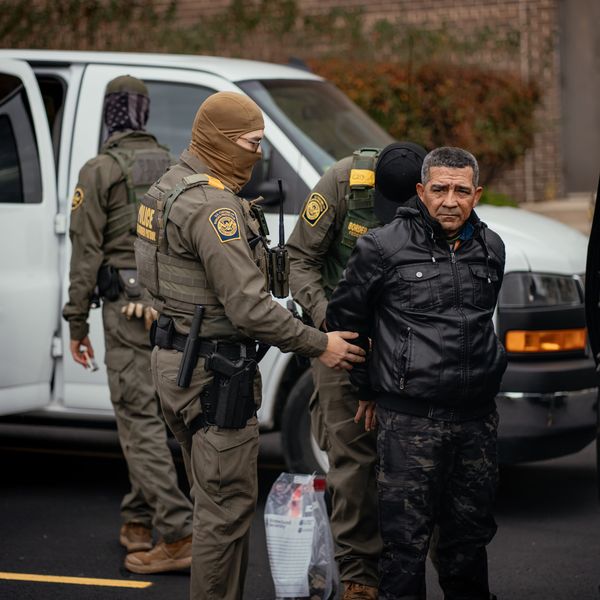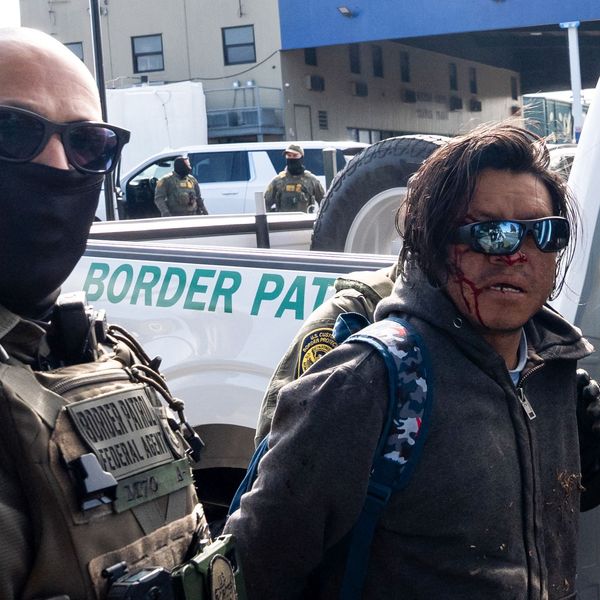Louisiana is Number One... in Incarceration
In 2014, the US Department of Justice confirmed Louisiana remained number 1, among the 50 states, with 38,030 in prison, a rate of 816 per 100,000 over 100 points ahead of next highest state Oklahoma. Because the US leads the world in incarcerating its people, this means Louisiana is number one in the world. Compare Louisiana's rate of 816 people per 100,000 with Russia's 492, China with 119, France with 100, and Germany with 78.
Louisiana first became number 1 in the nation in 2005 when it was imprisoning 36,083 people. Louisiana remained number 1, in 2010 with 35,207 in prison, an incarceration rate of 867 per 100,000 people, over 200 points head of the next highest state Mississippi.
It was not always so. In 1965, Louisiana ranked 13th nationally in putting its citizens in jail with a rate of 109 prisoners per 100,000 people. In 1978, Louisiana only held 7,291 people behind bars. By 1986, Louisiana was 5th highest in the nation in putting its own citizens in prison, with 14,580 behind bars, a rate of 322 per 100,000, according to the US Department of Justice. In 1990, Louisiana rose to 3rd highest in the nation, putting 18,599 behind bars, a rate of 427 per 100,000. In 2000, Louisiana moved to 2nd highest in the nation, imprisoning 35,047 behind bars, a rate of 801 per 100,000.
The number of prisoners expanded nation-wide as a result of the "war on drugs" which was conducted in a racist way to target blacks. But in Louisiana, the prisons also backed up when the practice of releasing prisoners for good behavior after 10 years and 6 months of their life sentences was ended in the 1970s.
Louisiana has been much more severe in sending black people to prison than whites, at least after black people were no longer slaves. In 1860, when the Civil War started, the population of the Louisiana penitentiary was two-thirds white. But by 1868, the population of Louisiana's penitentiary was two-thirds black.
Angola Penitentiary remains the largest maximum security prison in the United States. There are over 5000 prisoners at Angola alone. The average sentence for prisoners there is 93 years. About 95 percent of people serving time at Angola will die there under current laws.
It costs taxpayers an average of $23,000 a year for each inmate at Angola. Over 400 people, about 9 percent of those serving life in Louisiana, were convicted of non-violent offenses.
There are an additional 69,000 people in Louisiana on probation and parole.
Louisiana has a long history of running abusive prisons. In 1835, Louisiana was described as having "the worst prison in the United States." In 1952, after dozens of Angola inmates slashed their heel tendons in protest of barbaric conditions, Colliers magazine called Angola "America's worst prison." In 1970, the American Bar Association said conditions at Angola were "medieval, squalid and horrifying." By 1975, conditions were so terrible, a Federal judge declared Angola a "state of emergency."
An Urgent Message From Our Co-Founder
Dear Common Dreams reader, The U.S. is on a fast track to authoritarianism like nothing I've ever seen. Meanwhile, corporate news outlets are utterly capitulating to Trump, twisting their coverage to avoid drawing his ire while lining up to stuff cash in his pockets. That's why I believe that Common Dreams is doing the best and most consequential reporting that we've ever done. Our small but mighty team is a progressive reporting powerhouse, covering the news every day that the corporate media never will. Our mission has always been simple: To inform. To inspire. And to ignite change for the common good. Now here's the key piece that I want all our readers to understand: None of this would be possible without your financial support. That's not just some fundraising cliche. It's the absolute and literal truth. We don't accept corporate advertising and never will. We don't have a paywall because we don't think people should be blocked from critical news based on their ability to pay. Everything we do is funded by the donations of readers like you. Will you donate now to help power the nonprofit, independent reporting of Common Dreams? Thank you for being a vital member of our community. Together, we can keep independent journalism alive when it’s needed most. - Craig Brown, Co-founder |
In 2014, the US Department of Justice confirmed Louisiana remained number 1, among the 50 states, with 38,030 in prison, a rate of 816 per 100,000 over 100 points ahead of next highest state Oklahoma. Because the US leads the world in incarcerating its people, this means Louisiana is number one in the world. Compare Louisiana's rate of 816 people per 100,000 with Russia's 492, China with 119, France with 100, and Germany with 78.
Louisiana first became number 1 in the nation in 2005 when it was imprisoning 36,083 people. Louisiana remained number 1, in 2010 with 35,207 in prison, an incarceration rate of 867 per 100,000 people, over 200 points head of the next highest state Mississippi.
It was not always so. In 1965, Louisiana ranked 13th nationally in putting its citizens in jail with a rate of 109 prisoners per 100,000 people. In 1978, Louisiana only held 7,291 people behind bars. By 1986, Louisiana was 5th highest in the nation in putting its own citizens in prison, with 14,580 behind bars, a rate of 322 per 100,000, according to the US Department of Justice. In 1990, Louisiana rose to 3rd highest in the nation, putting 18,599 behind bars, a rate of 427 per 100,000. In 2000, Louisiana moved to 2nd highest in the nation, imprisoning 35,047 behind bars, a rate of 801 per 100,000.
The number of prisoners expanded nation-wide as a result of the "war on drugs" which was conducted in a racist way to target blacks. But in Louisiana, the prisons also backed up when the practice of releasing prisoners for good behavior after 10 years and 6 months of their life sentences was ended in the 1970s.
Louisiana has been much more severe in sending black people to prison than whites, at least after black people were no longer slaves. In 1860, when the Civil War started, the population of the Louisiana penitentiary was two-thirds white. But by 1868, the population of Louisiana's penitentiary was two-thirds black.
Angola Penitentiary remains the largest maximum security prison in the United States. There are over 5000 prisoners at Angola alone. The average sentence for prisoners there is 93 years. About 95 percent of people serving time at Angola will die there under current laws.
It costs taxpayers an average of $23,000 a year for each inmate at Angola. Over 400 people, about 9 percent of those serving life in Louisiana, were convicted of non-violent offenses.
There are an additional 69,000 people in Louisiana on probation and parole.
Louisiana has a long history of running abusive prisons. In 1835, Louisiana was described as having "the worst prison in the United States." In 1952, after dozens of Angola inmates slashed their heel tendons in protest of barbaric conditions, Colliers magazine called Angola "America's worst prison." In 1970, the American Bar Association said conditions at Angola were "medieval, squalid and horrifying." By 1975, conditions were so terrible, a Federal judge declared Angola a "state of emergency."
In 2014, the US Department of Justice confirmed Louisiana remained number 1, among the 50 states, with 38,030 in prison, a rate of 816 per 100,000 over 100 points ahead of next highest state Oklahoma. Because the US leads the world in incarcerating its people, this means Louisiana is number one in the world. Compare Louisiana's rate of 816 people per 100,000 with Russia's 492, China with 119, France with 100, and Germany with 78.
Louisiana first became number 1 in the nation in 2005 when it was imprisoning 36,083 people. Louisiana remained number 1, in 2010 with 35,207 in prison, an incarceration rate of 867 per 100,000 people, over 200 points head of the next highest state Mississippi.
It was not always so. In 1965, Louisiana ranked 13th nationally in putting its citizens in jail with a rate of 109 prisoners per 100,000 people. In 1978, Louisiana only held 7,291 people behind bars. By 1986, Louisiana was 5th highest in the nation in putting its own citizens in prison, with 14,580 behind bars, a rate of 322 per 100,000, according to the US Department of Justice. In 1990, Louisiana rose to 3rd highest in the nation, putting 18,599 behind bars, a rate of 427 per 100,000. In 2000, Louisiana moved to 2nd highest in the nation, imprisoning 35,047 behind bars, a rate of 801 per 100,000.
The number of prisoners expanded nation-wide as a result of the "war on drugs" which was conducted in a racist way to target blacks. But in Louisiana, the prisons also backed up when the practice of releasing prisoners for good behavior after 10 years and 6 months of their life sentences was ended in the 1970s.
Louisiana has been much more severe in sending black people to prison than whites, at least after black people were no longer slaves. In 1860, when the Civil War started, the population of the Louisiana penitentiary was two-thirds white. But by 1868, the population of Louisiana's penitentiary was two-thirds black.
Angola Penitentiary remains the largest maximum security prison in the United States. There are over 5000 prisoners at Angola alone. The average sentence for prisoners there is 93 years. About 95 percent of people serving time at Angola will die there under current laws.
It costs taxpayers an average of $23,000 a year for each inmate at Angola. Over 400 people, about 9 percent of those serving life in Louisiana, were convicted of non-violent offenses.
There are an additional 69,000 people in Louisiana on probation and parole.
Louisiana has a long history of running abusive prisons. In 1835, Louisiana was described as having "the worst prison in the United States." In 1952, after dozens of Angola inmates slashed their heel tendons in protest of barbaric conditions, Colliers magazine called Angola "America's worst prison." In 1970, the American Bar Association said conditions at Angola were "medieval, squalid and horrifying." By 1975, conditions were so terrible, a Federal judge declared Angola a "state of emergency."

